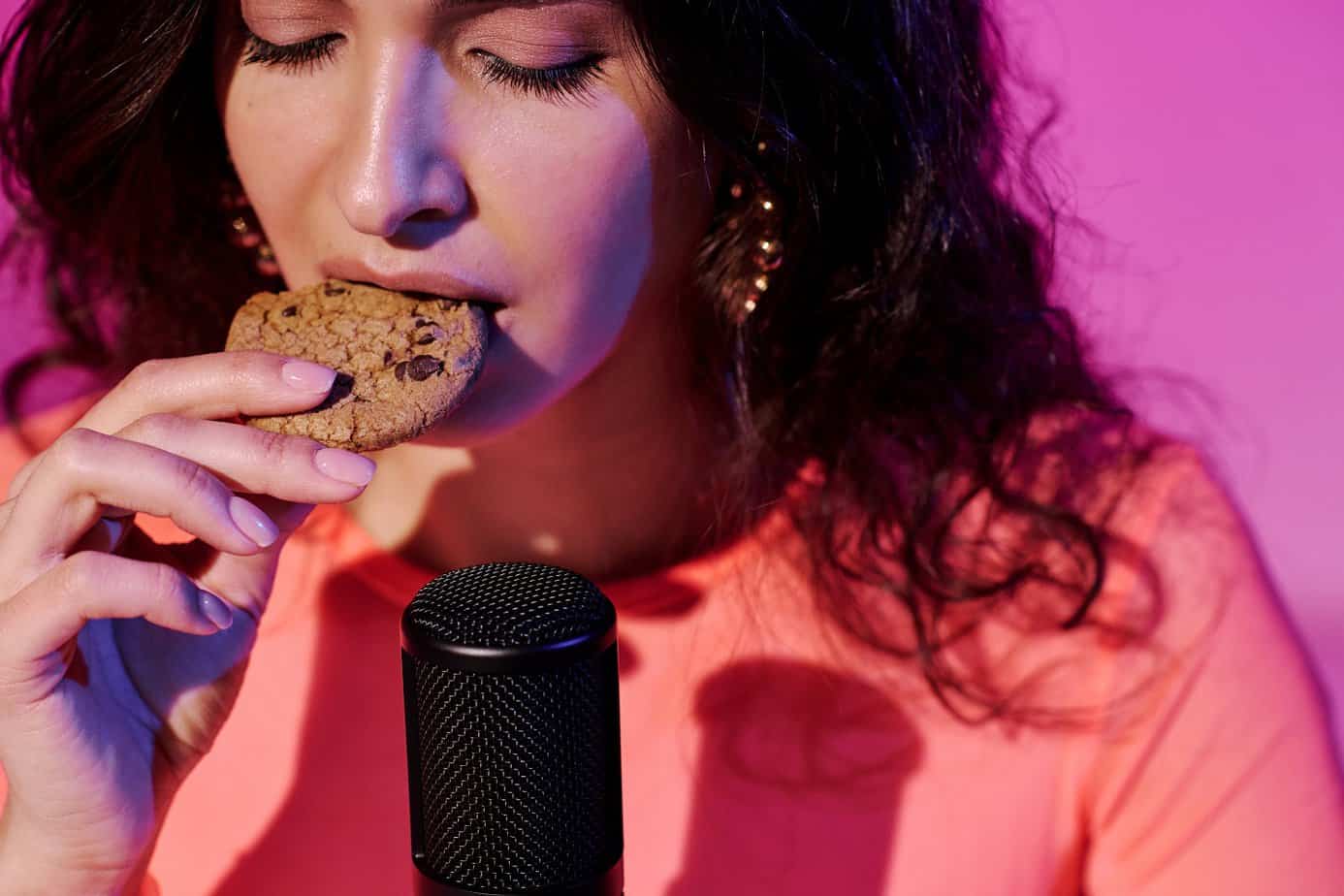100+ ASMR Niche and Trigger Ideas for Top-Notch Content

If you’ve ever dreamed of starting your own ASMR channel, then you’re in good company. There is a huge audience for the soothing sounds and visuals offered through ASMR, and there’s something incredibly appealing about creating content that can help others relax and unwind. On the flip side, considering a venture into the vast world of ASMR can be overwhelming, leaving you unsure where to begin.
There are hundreds of potential ASMR triggers from which to choose, and the possibilities are endless. In order to set yourself apart from the competition and cultivate a loyal following, you will need to find a unique niche within the ASMR community. Begin by focusing on a single niche to allow you to hone your skills and develop a distinct style that appeals to a specific audience.
Choose from an extensive array of niche and trigger ideas to jump-start your creativity as an ASMRtist. Take advantage of this treasure trove of inspiration to confidently keep your content schedule full for months on end, allowing you to explore various avenues and fulfill your true passion within the realm of ASMR.
We foster relationships with brands we use and trust. The testimonials on our site represent real experiences, but they don’t guarantee you’ll achieve similar results. When you make purchases through our links to our partners, we may earn a commission. Your support helps us continue this work. You can read our full disclosure here.
ASMR Niches vs Triggers
ASMR niches and triggers are two distinct, yet interconnected, concepts within the world of Autonomous Sensory Meridian Response (ASMR) content creation. Aspiring ASMRtists who wish to create effective and engaging content for their audiences must understand the difference between these terms.
ASMR Niche
ASMR niches are specific categories or themes within the broader ASMR landscape. They usually encompass a particular style, subject matter, or type of content that appeals to a certain subset of the ASMR audience. Focusing on a niche allows ASMRtists to target their content to a specific group of viewers and stand out in the competitive world of ASMR content creation. Examples of ASMR niches include whispered storytelling, role-playing, personal attention, sound assortments, and nature sounds.
ASMR Trigger
Conversely, ASMR triggers are specific sounds, visuals, or actions that elicit the tingling sensation associated with ASMR. Triggers are the individual elements used within ASMR content to create a relaxing and immersive experience for the viewer. They can be auditory, visual, or tactile in nature and are used by ASMRtists to stimulate the ASMR response. Common triggers include whispering, tapping, brushing, crinkling, and hand movements.
An ASMR niche represents the content’s overall theme or category, while an ASMR trigger is a specific element used within that content, to induce the desired ASMR response. ASMRtists combine various triggers within a chosen niche to create unique and engaging content that resonates with their target audiences and helps them build a dedicated following.
Related: How to Start a YouTube Channel on Your Phone
100+ ASMR Niches and Trigger Ideas for ASMRtists

The following list will provide you with a diverse array of ASMR niches complete with trigger ideas that cater to different interests and preferences. Whether you are simply an ASMR enthusiast or an experienced creator, these ideas will inspire and guide you toward a satisfying and successful career in the world of ASMR.
- Whispered storytelling: Reading classic literature, fairy tales, or original stories in a soft, whispered voice.
- Personal attention role plays: Acting as a hairdresser, doctor, or spa therapist to create a relaxing experience for the listener.
- Tapping and scratching: Using various objects like glass, wood, or plastic to produce soothing tapping and scratching sounds.
- Cooking and baking: Preparing and cooking meals or baking treats, focusing on the sounds of chopping, mixing, and sizzling.
- Nature and ambient sounds: Recording and sharing the sounds of rain, ocean waves, or a crackling fire for relaxation and meditation.
- Art and drawing: Creating art while narrating the process and capturing the sounds of pencils, brushes, and other art tools.
- Unboxing and product reviews: Opening packages, handling products, and describing their features while focusing on the sounds they make.
- Makeup and skincare routines: Demonstrating makeup application, skincare routines, or beauty product reviews with emphasis on the soothing sounds.
- Eating and mouth sounds: Enjoying various types of foods while focusing on the sounds of chewing, crunching, and sipping.
- Page-turning and book handling: Flipping through books or magazines, capturing the sounds of pages turning and fingers running over paper.
- Travel and exploration: Visiting interesting locations and capturing the unique sounds of those environments such as busy markets, quiet forests, or bustling cities.
- Crafting and DIY projects: Demonstrating how to create handmade items while capturing the sounds of cutting, sewing, or assembling materials.
- Calligraphy and handwriting: Writing beautiful letters or quotes while capturing the sounds of pens, ink, and paper.
- Kinetic sand and slime: Manipulating and playing with kinetic sand, slime, or other sensory materials to showcase their soothing sounds.
- Typing and keyboard sounds: Typing on various keyboards, including mechanical, vintage, or laptop, to create a range of clicky and calming noises.
- Soft singing or humming: Gently singing lullabies, popular tunes, or original songs to provide a soothing auditory experience.
- Guided meditation and relaxation: Leading listeners through guided meditations or relaxation exercises, using a calming voice.
- Foreign language lessons: Teaching basic phrases or vocabulary in different languages with a focus on sound and pronunciation.
- Water sounds: Playing with water, pouring it, or running it over various surfaces to capture its calming effects.
- Crinkling and rustling: Exploring the sounds made by different materials like plastic, foil, or paper when they are crinkled or rustled.
- Origami and paper-folding: Demonstrating how to make origami creations or other paper crafts while capturing the sounds of folding and creasing.
- Cleaning and organizing: Tidying spaces like drawers or closets, while focusing on the sounds of items being moved and arranged.
- Brushing and combing: Capturing the soothing sounds of brushing hair, fur, or other textured surfaces.
- Gaming and controller sounds: Playing video games while capturing the clicks and clacks of controllers, keyboards, or other gaming peripherals.
- Puzzles and board games: Assembling puzzles, playing board games, or solving brain teasers while focusing on the sounds of pieces moving and interacting.
- Layered sounds: Combining multiple ASMR triggers to create a rich and immersive listening experience.
- Reiki and energy healing: Performing reiki or other energy healing techniques on camera, often with accompanying soft-spoken explanations.
- Binaural and 3D audio: Recording ASMR using binaural microphones or creating 3D audio experiences for an immersive sensation.
- Pottery and sculpting: Working with clay or other sculpting materials to capture the sounds of shaping, smoothing, and molding.
- Woodworking and carving: Crafting wooden items while focusing on the sounds of cutting, sanding, and chiseling.
- Fabric sounds: Exploring the sounds of various fabrics like silk, velvet, or leather, when they are touched, rubbed, or manipulated.
- Collection show and tell: Showcasing personal collections, such as stamps, coins, or memorabilia, while discussing their history and significance in a soothing manner.
- Glassblowing and handling: Demonstrating the art of glassblowing or handling glass items to capture their unique sounds.
- LEGO building: Assembling LEGO sets while focusing on the bricks’ satisfying clicks and snaps.
- Gardening and plant care: Tending to plants, repotting, or watering, while capturing the sounds of soil, leaves, and tools.
- Tea and coffee brewing: Preparing tea or coffee, emphasizing the sounds of water pouring, tea leaves rustling, and coffee beans grinding.
- Shoe polishing and leather care: Cleaning and maintaining leather shoes or items, showcasing the sounds of brushing and buffing.
- Scalp massage and hair play: Performing scalp massages or playing with hair to create soothing tactile sounds.
- Clocks and watches: Showcasing the ticking and mechanical sounds of various clocks and watches.
- Soap carving and cutting: Carving or cutting soap bars to create satisfying visuals and sounds.
- Vintage item exploration: Handling and discussing the history of vintage items like typewriters, cameras, or vinyl records, while capturing their unique sounds.
- Bubble wrap and packing material: Popping bubble wrap or handling other packing materials for their auditory appeal.
- Jewelry handling: Showcasing different pieces of jewelry while focusing on the sounds of chains, beads, and metal clinking.
- Textured surfaces: Running fingers or objects across various textured surfaces, such as carpets, wallpapers, or upholstery, to create intriguing sounds.
- Match lighting and candle rituals: Lighting matches or candles and performing relaxation rituals in a calming atmosphere.
- Foam cutting and shaping: Cutting and shaping foam materials, like floral foam or memory foam, for their satisfying sounds.
- Whispered affirmations: Sharing positive affirmations and uplifting messages in a gentle whisper.
- Record player and vinyl sounds: Playing vinyl records and focusing on needle sounds, spinning, and vinyl crackling.
- Chalkboard and chalk sounds: Writing or drawing on a chalkboard to capture the sounds of chalk against the surface.
- Sewing and embroidery: Demonstrating sewing or embroidery techniques while capturing the sounds of thread, fabric, and needles.
- Paint mixing and color blending: Mixing paint colors and blending them together on a palette or canvas, accompanied by soothing narration.
- Antique store browsing: Visiting antique stores and exploring the unique items, discussing their history, and capturing their distinct sounds.
- Ice and frozen objects: Handling ice cubes or other frozen items, focusing on the sounds of cracking, melting, and clinking.
- Puzzle-solving: Solving Rubik’s cubes, lock puzzles, or other tactile puzzles while capturing the sounds of twisting and turning.
- Astronomy and stargazing: Discussing celestial bodies, constellations, and space exploration in a soft-spoken or whispered voice.
- Soft-spoken book reviews: Sharing opinions about books and literature in a calming, soft-spoken manner.
- Nail care and nail art: Demonstrating nail care routines or creating nail art designs while capturing the sounds of filing, painting, and tool usage.
- Wine tasting and cork tapping: Sampling different wines and discussing their flavors, accompanied by the sounds of pouring, swirling, and cork tapping.
- Model building and painting: Assembling and painting model kits like airplanes, cars, or figurines, while capturing the sounds of tools and materials.
- Crystal and gemstone exploration: Showcasing various crystals and gemstones, discussing their properties, and capturing the sounds of handling and tapping.
- Mindful breathing exercises: Guiding listeners through breathing exercises to promote relaxation and stress relief.
- Soft-spoken interviews or Q&A sessions: Conducting interviews with interesting individuals or answering listener questions in a calming, soft-spoken tone.
- Instrument tuning and maintenance: Tuning and caring for musical instruments like guitars, pianos, or violins, while capturing their unique sounds.
- Whispered travelogues: Sharing travel experiences and stories in a gentle whisper, accompanied by visuals or ambient sounds.
- Handwriting analysis and graphology: Analyzing handwriting samples and discussing the traits they reveal, in a soothing manner.
- Language pronunciation practice: Focusing on the pronunciation of words or phrases in various languages, emphasizing the sounds and intonation.
- Soft-spoken history lessons: Sharing historical events, biographies, or interesting facts in a calming, soft-spoken tone.
- Feather and brush tickling: Gently tickling objects or surfaces with feathers or brushes to create subtle, soothing sounds.
- Shell and seashell exploration: Handling and discussing various types of shells, focusing on the sounds they make when tapped or rubbed together.
- Floral arrangement and flower care: Creating beautiful floral arrangements and discussing flower care while capturing the sounds of stems, leaves, and petals.
- Chess or strategy games: Playing chess or other strategy games, focusing on the sounds of moving pieces and providing soft-spoken commentary.
- Soft-spoken science discussions: Explaining scientific concepts, theories, or discoveries in a calming, soft-spoken manner.
- Slow-motion activities: Performing everyday tasks or movements in slow motion to emphasize the subtle sounds they produce.
- Stone and pebble handling: Exploring the sounds and textures of different stones, pebbles, or minerals through handling and tapping.
- Soft-spoken trivia and quizzes: Sharing interesting trivia facts or conducting quizzes in a calming, soft-spoken manner.
- Origami paper crinkling: Folding and unfolding origami paper to create satisfying crinkling sounds.
- Call center roleplay: Simulating call center interactions with a focus on keyboard typing, mouse clicking, and soothing customer service dialogue.
- Plucking and tuning string instruments: Capturing the sounds of plucking and tuning string instruments like guitars, violins, or harps.
- Hand lotion and massage sounds: Applying hand lotion and performing hand massages, capturing the sounds of rubbing and skin contact.
- Soft-spoken sports commentary: Discussing sporting events or specific athletes in a calming, soft-spoken voice.
- Fine art appreciation: Analyzing and discussing famous paintings, sculptures, or other works of art in a soothing tone.
- Rainstick and sound tube exploration: Creating relaxing sounds with rainsticks, sound tubes, or similar instruments.
- Whiteboard and marker sounds: Writing or drawing on a whiteboard with markers, focusing on the sounds they produce.
- Soft-spoken philosophy discussions: Explaining philosophical concepts, theories, or ideas in a calming, soft-spoken manner.
- Whispered poetry readings: Reciting poetry from various authors or eras in a gentle whisper.
- Guided visualizations: Leading listeners through guided visualizations to promote relaxation and stress relief.
- Soft-spoken film and TV show reviews: Discussing movies or TV shows in a calming, soft-spoken voice.
- Handheld video game sounds: Playing handheld video games and focusing on the sounds of buttons, switches, and gameplay.
- Soft-spoken fashion discussions: Analyzing fashion trends, designers, or runway shows in a calming, soft-spoken manner.
- Chopstick tapping and handling: Capturing the sounds of handling, tapping, and using chopsticks on various surfaces or objects.
- Soft-spoken technology reviews: Discussing gadgets, devices, or software in a soothing, soft-spoken voice.
- Clay molding and pottery wheel throwing: Shaping clay on a pottery wheel or by hand, capturing the sounds of wet clay and tools.
- Whispered guided tours: Providing whispered commentary while exploring museums, galleries, or other points of interest.
- Soft-spoken DIY tutorials: Demonstrating how to create DIY projects in a calming, soft-spoken manner.
- Dough kneading and bread making: Preparing dough and making bread, capturing the sounds of kneading, rolling, and baking.
- Soft-spoken game walkthroughs: Guiding listeners through video game levels or challenges in a calming, soft-spoken voice.
- Hand fan and folding fan sounds: Opening, closing, and waving hand fans or folding fans to create soothing, rhythmic sounds.
- Soft-spoken animal facts: Sharing interesting facts about animals, their habitats, and behaviors in a soothing tone.
- Bubble blowing and popping: Creating and popping bubbles with bubble solution or gum, capturing the sounds they produce.
- Whispered guided meditations: Leading listeners through guided meditations in a gentle whisper.
- Soft-spoken dream analysis: Discussing dream symbolism, interpretation, and theories in a calming, soft-spoken manner.
Related: How to Get Paid to Watch YouTube Videos
Consistency is Key to a Thriving ASMR Channel
The foundation of a successful ASMR channel is rooted in leveraging these niche and trigger ideas to create a content schedule that promotes consistency and appeals to your target audience. By concentrating on a specific niche and incorporating various triggers within that area, you can position yourself as an ASMRtist with a distinctive perspective and expertise.
Seize the opportunity to experiment with different triggers and niches while refining your style and technique along the way. Consistency is vital for success; maintaining a regular upload schedule and continuously expanding your content library will foster trust and loyalty among your audience.
Engage with your viewers and welcome feedback. Their insights can help you fine-tune your content and gain a better understanding about their preferences. Remain open to adapting and evolving as you learn more about your niche and the ASMR community at large. Collaborating with fellow ASMRtists can be a valuable way to broaden your reach and learn new techniques.
Motivate yourself by remembering the impact your content can have on your viewers’ lives. Your whispered stories or soothing sounds can provide your audience with relaxation, stress relief, and even personal growth. As an ASMRtist, you have the potential to create a positive ripple effect that reaches far beyond your channel, touching the lives of countless individuals.
With dedication, perseverance, and a genuine passion for your chosen niche, there’s no limit to what you can achieve as an ASMRtist. Explore these unique and stimulating ideas, create a schedule for your content, and kick-start your path toward growing a successful and profitable ASMR channel. The world is waiting for your unique voice and the comforting experiences you have to offer.
Related: Selfless Ways to Get Paid to Help Others







Please, I need this job.
Hi Ujunwa! You’re in luck with this opportunity because it doesn’t require you to update your resume or go through job interviews. Becoming an ASMR artist is as simple as starting a TikTok channel and adding high-quality content. This list can help you pick an ASMR niche and bring the best triggers to your audience to help them relax and sleep. That said, just because it’s “simple” to get started doesn’t mean it will be easy to make money. With a job like ASMR, whether you start on TikTok, YouTube, or another platform, you need to impress your audience (not your boss). Once you grow a following and monetize your channel, you can start earning some extra income and perhaps even replace a full-time job. We wish you all the best!